小学英语辅导网_小学英语教案.
- 格式:pdf
- 大小:540.73 KB
- 文档页数:19
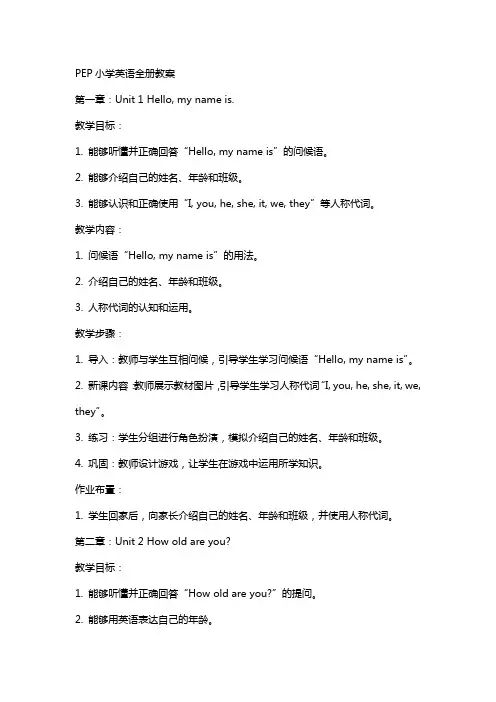
PEP小学英语全册教案第一章:Unit 1 Hello, my name is.教学目标:1. 能够听懂并正确回答“Hello, my name is”的问候语。
2. 能够介绍自己的姓名、年龄和班级。
3. 能够认识和正确使用“I, you, he, she, it, we, they”等人称代词。
教学内容:1. 问候语“Hello, my name is”的用法。
2. 介绍自己的姓名、年龄和班级。
3. 人称代词的认知和运用。
教学步骤:1. 导入:教师与学生互相问候,引导学生学习问候语“Hello, my name is”。
2. 新课内容:教师展示教材图片,引导学生学习人称代词“I, you, he, she, it, we, they”。
3. 练习:学生分组进行角色扮演,模拟介绍自己的姓名、年龄和班级。
4. 巩固:教师设计游戏,让学生在游戏中运用所学知识。
作业布置:1. 学生回家后,向家长介绍自己的姓名、年龄和班级,并使用人称代词。
第二章:Unit 2 How old are you?教学目标:1. 能够听懂并正确回答“How old are you?”的提问。
2. 能够用英语表达自己的年龄。
3. 能够认识和正确使用“I, you, he, she, it, we, they”等人称代词。
教学内容:1. 提问年龄的用法“How old are you?”。
2. 表达自己年龄的方式。
3. 人称代词的认知和运用。
教学步骤:1. 导入:教师与学生互相问候,引导学生学习问候语“How old are you?”。
2. 新课内容:教师展示教材图片,引导学生学习人称代词“I, you, he, she, it, we, they”。
3. 练习:学生分组进行角色扮演,模拟回答“How old are you?”的问题。
4. 巩固:教师设计游戏,让学生在游戏中运用所学知识。
作业布置:1. 学生回家后,向家长提问并回答“How old are you?”的问题。
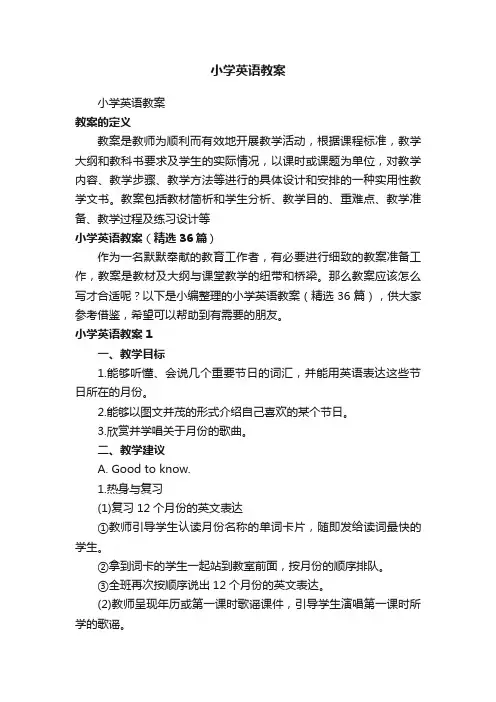
小学英语教案小学英语教案教案的定义教案是教师为顺利而有效地开展教学活动,根据课程标准,教学大纲和教科书要求及学生的实际情况,以课时或课题为单位,对教学内容、教学步骤、教学方法等进行的具体设计和安排的一种实用性教学文书。
教案包括教材简析和学生分析、教学目的、重难点、教学准备、教学过程及练习设计等小学英语教案(精选36篇)作为一名默默奉献的教育工作者,有必要进行细致的教案准备工作,教案是教材及大纲与课堂教学的纽带和桥梁。
那么教案应该怎么写才合适呢?以下是小编整理的小学英语教案(精选36篇),供大家参考借鉴,希望可以帮助到有需要的朋友。
小学英语教案1一、教学目标1.能够听懂、会说几个重要节日的词汇,并能用英语表达这些节日所在的月份。
2.能够以图文并茂的形式介绍自己喜欢的某个节日。
3.欣赏并学唱关于月份的歌曲。
二、教学建议A. Good to know.1.热身与复习(1)复习12个月份的英文表达①教师引导学生认读月份名称的单词卡片,随即发给读词最快的学生。
②拿到词卡的学生一起站到教室前面,按月份的顺序排队。
③全班再次按顺序说出12个月份的英文表达。
(2)教师呈现年历或第一课时歌谣课件,引导学生演唱第一课时所学的歌谣。
(3)师生交流:When is your birthday? It‘s in ...2.学习新知(1)教师呈现母亲节图片,引导学生观察画面内容,如:Who are they? What is the girl doing? Why is she giving flowers to her mother? Is it her mother’s birthday?...引出Mother‘s Day之后,让学生跟读词汇。
小学英语教案2一、语言技能目标第一层次:1.能够听懂、会说衣服词汇cap,coat,shoes,sweater,jacket,gloves,trousers;能在四线三格中基本规范地抄写单词,并尝试借助拼读规律记忆单词。
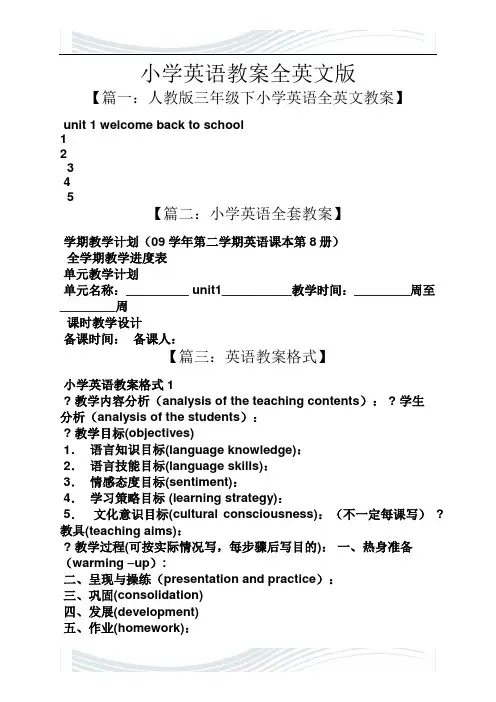
小学英语教案全英文版【篇一:人教版三年级下小学英语全英文教案】unit 1 welcome back to school12345【篇二:小学英语全套教案】学期教学计划(09学年第二学期英语课本第8册)全学期教学进度表单元教学计划单元名称:_________ unit1__________教学时间:________周至________周课时教学设计备课时间:备课人:【篇三:英语教案格式】小学英语教案格式1? 教学内容分析(analysis of the teaching contents): ? 学生分析(analysis of the students):? 教学目标(objectives)1.语言知识目标(language knowledge):2.语言技能目标(language skills):3.情感态度目标(sentiment):4.学习策略目标 (learning strategy):5.文化意识目标(cultural consciousness):(不一定每课写)? 教具(teaching aims):? 教学过程(可按实际情况写,每步骤后写目的):一、热身准备(warming –up):二、呈现与操练(presentation and practice):三、巩固(consolidation)四、发展(development)五、作业(homework):? 板书设计:? 附上练习:范例一:unit3 let’s talk 第一课时小学三年级教学重点:how are you? fine, thank you. 等问候语的学习。
教学难点: 1、how are you? 的得体运用。
2、fine, thank you.中 fine 一词字母 i 的发音不容易到位。
教具准备:1、本课let’s talk/a 部分的教学课件。
2、教师为学生准备3—4个扩音器。
3、本课时教学配套的录音带,以及歌曲“hello”“head, shoulders, knees and toes”的录音带。
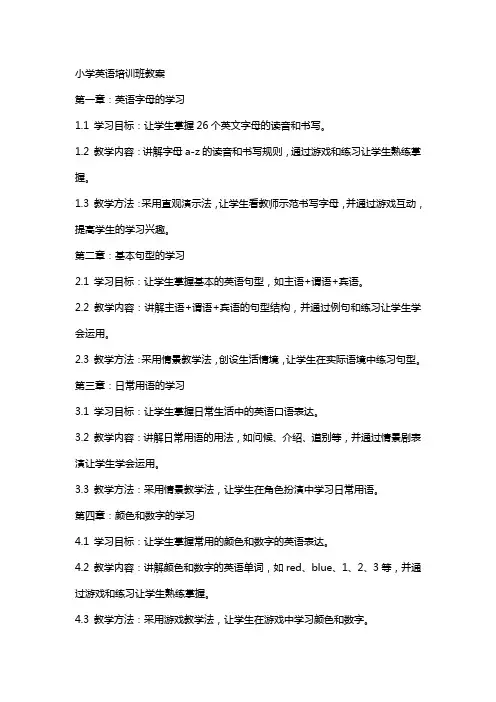
小学英语培训班教案第一章:英语字母的学习1.1 学习目标:让学生掌握26个英文字母的读音和书写。
1.2 教学内容:讲解字母a-z的读音和书写规则,通过游戏和练习让学生熟练掌握。
1.3 教学方法:采用直观演示法,让学生看教师示范书写字母,并通过游戏互动,提高学生的学习兴趣。
第二章:基本句型的学习2.1 学习目标:让学生掌握基本的英语句型,如主语+谓语+宾语。
2.2 教学内容:讲解主语+谓语+宾语的句型结构,并通过例句和练习让学生学会运用。
2.3 教学方法:采用情景教学法,创设生活情境,让学生在实际语境中练习句型。
第三章:日常用语的学习3.1 学习目标:让学生掌握日常生活中的英语口语表达。
3.2 教学内容:讲解日常用语的用法,如问候、介绍、道别等,并通过情景剧表演让学生学会运用。
3.3 教学方法:采用情景教学法,让学生在角色扮演中学习日常用语。
第四章:颜色和数字的学习4.1 学习目标:让学生掌握常用的颜色和数字的英语表达。
4.2 教学内容:讲解颜色和数字的英语单词,如red、blue、1、2、3等,并通过游戏和练习让学生熟练掌握。
4.3 教学方法:采用游戏教学法,让学生在游戏中学习颜色和数字。
第五章:家庭成员的介绍5.1 学习目标:让学生学会介绍家庭成员的英语表达。
5.2 教学内容:讲解家庭成员的英语单词,如mother、father、brother等,并通过情景剧让学生学会介绍家庭成员。
5.3 教学方法:采用情景教学法,让学生在角色扮演中学习家庭成员的介绍。
第六章:食物和饮料的认知6.1 学习目标:让学生掌握基本的食品和饮料的英语单词,并能简单描述自己的喜好。
6.2 教学内容:讲解食品和饮料的英语单词,如apple、banana、milk、water 等,并通过图片展示和练习让学生熟练掌握。
6.3 教学方法:采用直观教学法,让学生通过图片和实物认知单词,并通过游戏练习口语表达。
第七章:天气的表达7.1 学习目标:让学生学会描述天气的英语表达。
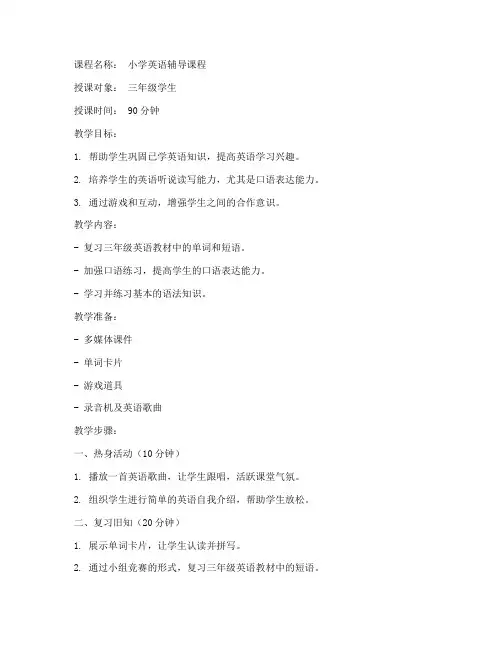
课程名称:小学英语辅导课程授课对象:三年级学生授课时间: 90分钟教学目标:1. 帮助学生巩固已学英语知识,提高英语学习兴趣。
2. 培养学生的英语听说读写能力,尤其是口语表达能力。
3. 通过游戏和互动,增强学生之间的合作意识。
教学内容:- 复习三年级英语教材中的单词和短语。
- 加强口语练习,提高学生的口语表达能力。
- 学习并练习基本的语法知识。
教学准备:- 多媒体课件- 单词卡片- 游戏道具- 录音机及英语歌曲教学步骤:一、热身活动(10分钟)1. 播放一首英语歌曲,让学生跟唱,活跃课堂气氛。
2. 组织学生进行简单的英语自我介绍,帮助学生放松。
二、复习旧知(20分钟)1. 展示单词卡片,让学生认读并拼写。
2. 通过小组竞赛的形式,复习三年级英语教材中的短语。
3. 播放相关英语短文,让学生跟读并回答问题。
三、口语练习(30分钟)1. 分组进行角色扮演,练习日常生活中的英语对话。
2. 邀请学生上台表演,其他学生评价。
3. 教师针对学生的发音和语法错误进行纠正。
四、语法学习(20分钟)1. 通过图片和例句,讲解基本的英语语法知识。
2. 学生完成语法练习题,巩固所学知识。
五、总结与作业(10分钟)1. 教师对本节课所学内容进行总结。
2. 布置课后作业,包括单词拼写、短语练习和口语练习。
教学评价:1. 观察学生在课堂上的参与度和表现。
2. 评价学生的口语表达能力和语法掌握情况。
3. 收集学生作业,了解学生的学习效果。
课后反思:1. 评估教学效果,总结教学过程中的优点和不足。
2. 根据学生的反馈,调整教学内容和方法。
3. 持续关注学生的英语学习情况,为下一节课做好准备。
---注意事项:1. 在教学过程中,要注意营造轻松愉快的课堂氛围,激发学生的学习兴趣。
2. 针对不同学生的学习水平,采取分层教学,确保每个学生都能有所收获。
3. 注重学生的个体差异,关注学生的情感需求,给予学生充分的鼓励和支持。
4. 定期与家长沟通,了解学生在家的学习情况,共同促进学生的英语学习。
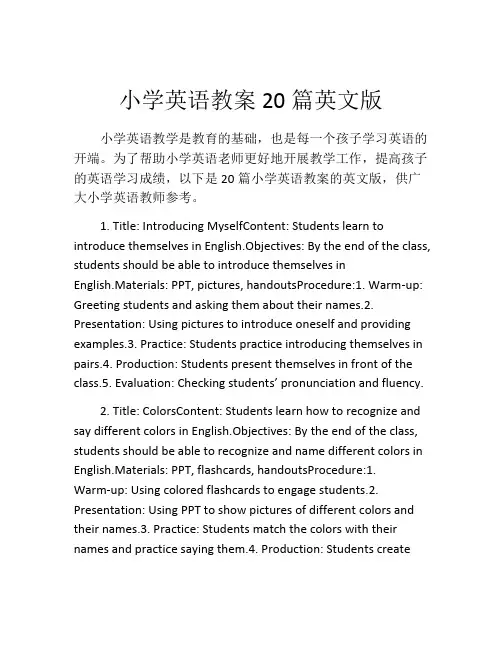
小学英语教案20篇英文版小学英语教学是教育的基础,也是每一个孩子学习英语的开端。
为了帮助小学英语老师更好地开展教学工作,提高孩子的英语学习成绩,以下是20篇小学英语教案的英文版,供广大小学英语教师参考。
1. Title: Introducing MyselfContent: Students learn to introduce themselves in English.Objectives: By the end of the class, students should be able to introduce themselves inEnglish.Materials: PPT, pictures, handoutsProcedure:1. Warm-up: Greeting students and asking them about their names.2. Presentation: Using pictures to introduce oneself and providing examples.3. Practice: Students practice introducing themselves in pairs.4. Production: Students present themselves in front of the class.5. Evaluation: Checking students’ pronunciation and fluency.2. Title: ColorsContent: Students learn how to recognize and say different colors in English.Objectives: By the end of the class, students should be able to recognize and name different colors in English.Materials: PPT, flashcards, handoutsProcedure:1.Warm-up: Using colored flashcards to engage students.2. Presentation: Using PPT to show pictures of different colors and their names.3. Practice: Students match the colors with their names and practice saying them.4. Production: Students createtheir own pictures and describe them in English.5. Evaluation: Checking students’ ability to recognize and name different colors.3. Title: NumbersContent: Students learn how to recognize and say the numbers from 1 to 20 in English.Objectives: By the end of the class, students should be able to recognize and say the numbers from 1 to 20 in English.Materials: PPT, flashcards, handoutsProcedure:1. Warm-up: Using number flashcards to engage students.2. Presentation: Using PPT to show pictures of the numbers from 1 to 20 and their names.3. Practice: Students match the numbers with their names and practice saying them.4. Production: Students practice counting in English and count the number of objects in the classroom.5. Evaluation: Checking students’ ability to recognize and say the numbers from 1 to 20.4. Title: ShapesContent: Students learn how to recognize and name different shapes in English.Objectives: By the end of the class, students should be able to recognize and name different shapes in English.Materials: PPT, flashcards, handoutsProcedure:1. Warm-up: Using shape flashcards to engage students.2. Presentation: Using PPT to show pictures of different shapes and their names.3. Practice: Students match the shapes with their names and practice saying them.4. Production: Students create their own pictures using different shapes and describe them in English.5. Evaluation: Checki ng students’ ability to recognize and name different shapes.5. Title: FamilyContent: Students learn how to talk about their family members in English.Objectives: By the end of the class, students should be able to talk about their family members in English.Materials: PPT, flashcards, handoutsProcedure:1.Warm-up: Asking students about their family members.2. Presentation: Using PPT to show pictures of different family members and their names.3. Practice: Students practice talking about their family members in pairs.4. Production: Students present their family members in front of the class.5. Evaluation: Checking students’ ability to talk about their family members in English.6. Title: AnimalsContent: Students learn how to recognize and name different animals in English.Objectives: By the end of the class, students should be able to recognize and name different animals in English.Materials: PPT, flashcards, handoutsProcedure:1. Warm-up: Using animal flashcards to engage students.2. Presentation: Using PPT to show pictures of different animals and their names.3. Practice: Students match the animals with their names and practice saying them.4. Production: Students create their own pictures using different animals and describe them in English.5. Evaluation: Chec king students’ ability to recognize and name different animals.7. Title: WeatherContent: Students learn how to recognize and name different types of weather in English.Objectives: By the end of the class, students should be able to recognize and name different types of weather in English.Materials: PPT, flashcards,handoutsProcedure:1. Warm-up: Asking students about the weather outside.2. Presentation: Using PPT to show pictures of different types of weather and their names.3. Practice: Students practice recognizing and naming different types of weather.4. Production: Students describe the weather in a particular place.5. Evaluation: Checking students’ ability to recognize and name different types of weather.8. Title: Food and DrinksContent: Students learn how to recognize and name different types of food and drinks in English.Objectives: By the end of the class, students should be able to recognize and name different types of food and drinks in English.Materials: PPT, flashcards, handoutsProcedure:1.Warm-up: Asking students about their favorite food and drinks.2. Presentation: Using PPT to show pictures of different types of food and drinks and their names.3. Practice: Students practice recognizing and naming different types of food and drinks.4. Production: Students decide on a menu and describe the food and drinks in English.5. Evaluation: Checking students’ ability to recognize and name different types of food and drinks.9. Title: My BodyContent: Students learn how to recognize and name different parts of the body in English.Objectives: By the end of the class, students should be able to recognize and name different parts of the body in English.Materials: PPT, flashcards, handoutsProcedure:1. Warm-up: Asking students about different parts of the body.2. Presentation: Using PPT to show pictures of different parts of the body and their names.3. Practice: Studentspractice recognizing and naming different parts of the body.4. Production: Students draw a person and label the different parts of the body in Eng lish.5. Evaluation: Checking students’ ability to recognize and name different parts of the body.10. Title: JobsContent: Students learn how to recognize and name different types of jobs in English.Objectives: By the end of the class, students should be able to recognize and name different types of jobs in English.Materials: PPT, flashcards, handoutsProcedure:1. Warm-up: Asking students about their dream job.2. Presentation: Using PPT to show pictures of different types of jobs and their names.3. Practice: Students practice recognizing and naming different types of jobs.4. Production: Students choose a job and describe it in English.5. Evaluation: Checking students’ ability to recognize and name different types of jobs.11. Title: Days of the WeekContent: Students learn how to recognize and say the days of the week in English.Objectives: By the end of the class, students should be able to recognize and say the days of the week in English.Materials: PPT, flashcards, handoutsProcedure:1. Warm-up: Asking students about their favorite day of the week.2. Presentation: Using PPT to show pictures of the days of the week and their names.3. Practice: Students practice recognizing and saying the days of the week.4. Production: Students describe their schedule for the week.5. Evaluation: Checking students’ ability to recognize and say the days of the week.12. Title: Months of the YearContent: Students learn how to recognize and say the months of the year in English.Objectives: By the end of the class, students should be able to recognize and say the months of the year in English.Materials: PPT, flashcards, handoutsProcedure:1. Warm-up: Asking students about their favorite month of the year.2. Presentation: Using PPT to show pictures of the months of the year and their names.3. Practice: Students practice recognizing and saying the months of the year.4. Production: Students describe their favorite season and the months that belong to it.5. Evaluation: Checking students’ ability to recognize and say the months of the year.13. Title: TimeContent: Students learn how to tell the time in English.Objectives: By the end of the class, students should be able to tell the time in English.Materials: PPT, flashcards, handoutsProcedure:1. Warm-up: Asking students about their favorite time of the day.2. Presentation: Using PPT to show pictures of the clock and different times.3. Practice: Students practice telling the time in English.4. Production: Students plan their daily schedule and write it in English.5. Evaluation: Checking students’ ability to tell the time in English.14. Title: Weather ForecastContent: Students learn how to give a weather forecast in English.Objectives: By the end of the class, students should be able to give a weather forecast in English.Materials: PPT, flashcards, handoutsProcedure:1.Warm-up: Asking students about the weather outside.2. Presentation: Using PPT to show different weather conditions andvocabulary.3. Practice: Students practice giving a weather forecast in pairs.4. Production: Students give a weather forecast in front of the class.5. Evaluation: Checking students’ ability to give a weather forecast in English.15. Title: SeasonsContent: Students learn how to recognize and name the different seasons in English.Objectives: By the end of the class, students should be able to recognize and name the different seasons in English.Materials: PPT, flashcards, handoutsProcedure:1. Warm-up: Asking students about their favorite season.2. Presentation: Using PPT to show pictures of the different seasons and their names.3. Practice: Students practice recognizing and naming the different seasons.4. Production: Students write a paragraph about their favorite season in English.5. Evaluation: Checking students’ ability to recognize and name the different seasons in English.16. Title: ToysContent: Students learn how to recognize and name different types of toys in English.Objectives: By the end of the class, students should be able to recognize and name different types of toys in English.Materials: PPT, flashcards, handoutsProcedure:1. Warm-up: Asking students about their favorite toy.2. Presentation: Using PPT to show pictures of different types of toys and their names.3. Practice: Students practice recognizing and naming different types of toys.4. Production: Students describe their favorite toy in English.5. Evaluation: Checking students’ ability to recognize and name different types of toys.17. Title: School SuppliesContent: Students learn how to recognize and name different school supplies in English.Objectives: By the end of the class, students should be able to recognize and name different school supplies in English.Materials: PPT, flashcards, handoutsProcedure:1. Warm-up: Asking students about their favorite school supply.2. Presentation: Using PPT to show pictures of different school supplies and their names.3. Practice: Students practice recognizing and naming different school supplies.4. Production: Students describe the contents of their school bag in English.5. Evaluation: Checking students’ ability to recognize and name different school supplies.18. Title: Parts of a HouseContent: Students learn how to recognize and name different parts of a house inEnglish.Objectives: By the end of the class, students should be able to recognize and name different parts of a house in English.Materials: PPT, flashcards, handoutsProcedure:1.Warm-up: Asking students about the different rooms in their house.2. Presentation: Using PPT to show pictures of different parts of a house and their names.3. Practice: Students practice recognizing and naming different parts of a house.4. Production: Students describe their favorite room in their house in English.5. Evaluation: Checking students’ ability to recognize and name different parts of a house.19. Title: HolidaysContent: Students learn how to recognize and name different holidays in English.Objectives: By the end of the class, students should be able to recognize and name differentholidays in English.Materials: PPT, flashcards, handoutsProcedure:1. Warm-up: Asking students about their favorite holiday.2. Presentation: Using PPT to show pictures of different holidays and their names.3. Practice: Students practice recognizing and naming different holidays.4. Production: Students write about their favorite holiday in English.5. Evaluation: Checking students’ ability to recognize and name different holidays in English.20. Title: SportsContent: Students learn how to recognize and name different sports in English.Objectives: By the end of the class, students should be able to recognize and name different sports in English.Materials: PPT, flashcards, handoutsProcedure:1. Warm-up: Asking students about their favorite sport.2. Presentation: Using PPT to show pictures of different sports and their names.3. Practice: Students practice recognizing and naming different sports.4. Production: Students describe their favorite sport in English.5. Evaluation: Checking students’ ability to recognize and name different sports in English.以上是20篇小学英语教案的英文版,它们覆盖了小学英语教学的各个方面。
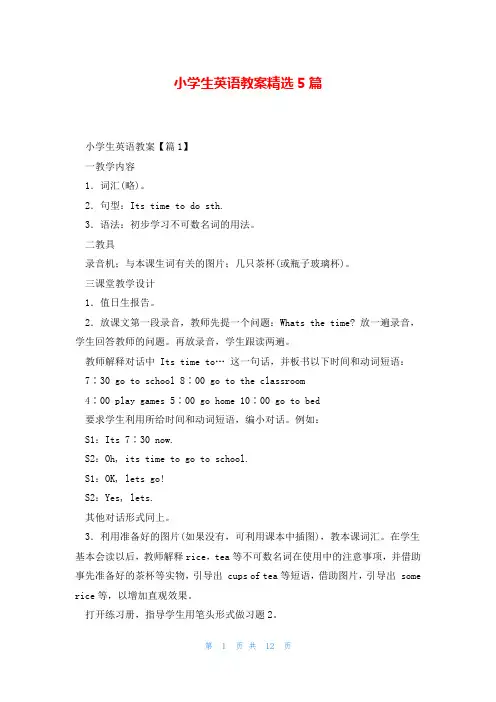
小学生英语教案精选5篇小学生英语教案【篇1】一教学内容1.词汇(略)。
2.句型:Its time to do sth.3.语法:初步学习不可数名词的用法。
二教具录音机;与本课生词有关的图片;几只茶杯(或瓶子玻璃杯)。
三课堂教学设计1.值日生报告。
2.放课文第一段录音,教师先提一个问题:Whats the time? 放一遍录音,学生回答教师的问题。
再放录音,学生跟读两遍。
教师解释对话中 Its time to…这一句话,并板书以下时间和动词短语:7∶30 go to school 8∶00 go to the classroom4∶00 play games 5∶00 go home 10∶00 go to bed要求学生利用所给时间和动词短语,编小对话。
例如:S1:Its 7∶30 now.S2:Oh, its time to go to school.S1:OK, lets go!S2:Yes, lets.其他对话形式同上。
3.利用准备好的图片(如果没有,可利用课本中插图),教本课词汇。
在学生基本会读以后,教师解释rice,tea等不可数名词在使用中的注意事项,并借助事先准备好的茶杯等实物,引导出 cups of tea等短语,借助图片,引导出 some rice等,以增加直观效果。
打开练习册,指导学生用笔头形式做习题2。
4.教师可反复利用手中实物或图片,不断变换,要求学生用英语表达:T:(举起一碗米饭的图片)Ss:Some riceT:(换成几只茶杯)Ss:three cups of tea (four, five etc.)这个练习可集体与个人形式相结合。
5.指导学习做练习册其他习题。
6.布置作业1)抄写生词;2)完成练习册习题。
四难点讲解a cup of tea 一杯茶tea, milk, orange, water等词是不可数名词,本身没有复数形式。
要表示它的量的多少,可借助 a cup/bottle/glass of等短语。
![[牛津中小学英语网]新译林6AUnit7 第二课时教案](https://uimg.taocdn.com/6c4d29a3b90d6c85ec3ac6ea.webp)
小学《英语》(六年级上册)Unit 7 Protect the Earth (Period 2)Teaching contents教学内容:Grammar time, & Fun timeTeaching aims and learning objectives教学目标:1 Pupils have a review of the story time.2 Pupils can grasp the use of the modal verb: should/should not.3 Pupils can make sentences with use…to…4 Pupils can reuse the things and they can describe.5 Pupils realize the earth is the only home, they should try their best to protect theEarth.Focus of the lesson and predicted area of difficulty教学重难点:1 Pupils can grasp the use of the modal verb: should.2 Pupils can make sentences with use…to…Preparation教学准备:PPT,预先请学生做好二次利用的物品,Teaching procedures教学过程:Step 1 Warm up1 T shows the picture of the earth, it’s healthy, then shows another picture of it, it’s ill. T: Boys and girls, what’s wrong with the Earth?Ss: It’s ill/unhealthy.T:What should we do?Ss: We should…(出示protect the Earth)T: Do you want to be the little environment protector?Let’s try to be one, Mr Brown, Chairman of the World Environment Organization, will recruit some Chinese volunteers, do you want to be the volunteers? You must finish some tasks.Step 2 RevisionTask1:Know how to protect the EarthSs answer this question: Save the water, save energy…Teacher shows respective pictures. (Review main ideas of the story time)T: Let’s review some new words.Show pictures: coal, oil, wood, plastic, paper.Task2: Know how to deal with these thingsRead and judge1. There is not much water in many places. ( )2. Cars do not use much energy. ( )3. We should not cut down trees. ( )4. Trees help keep the air clean. ( )5. We should not use plastic bags because they are not useful. ( )Ss judge them.Think and writeHow to protect the Earth1. We should save_______ and________ water.We should not_______ water.2. We should save_________.We should not _______ so much.3. We should save __________.We should not cut down too many________.4. We should not use too many ________ bags or bottles.We should use ______ bags and bottles.Pupils fill in the blanks and show the answers.Step 3 Presentation & PracticeTask3 Know the meanings of the signs and obey(遵守) themTeacher shows 4 public signs, pupils must use we should/should not….to make sentences.We should put rubbish in the bin,We should not use much napkin paper.We should not smoke.We should not pick flowers in the park.Teacher guides pupils to learn the use of should/should not: Grammar time.T: There are some sentences in story time about should/should not, read them and try to find the rules.T shows the rules:should:情态动词,含义是应该,后面跟动词的原型。
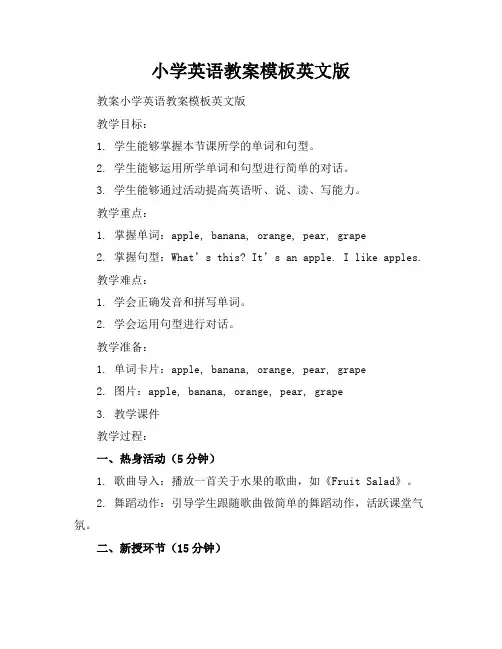
小学英语教案模板英文版教案小学英语教案模板英文版教学目标:1. 学生能够掌握本节课所学的单词和句型。
2. 学生能够运用所学单词和句型进行简单的对话。
3. 学生能够通过活动提高英语听、说、读、写能力。
教学重点:1. 掌握单词:apple, banana, orange, pear, grape2. 掌握句型:What’s this? It’s an apple. I like apples.教学难点:1. 学会正确发音和拼写单词。
2. 学会运用句型进行对话。
教学准备:1. 单词卡片:apple, banana, orange, pear, grape2. 图片:apple, banana, orange, pear, grape3. 教学课件教学过程:一、热身活动(5分钟)1. 歌曲导入:播放一首关于水果的歌曲,如《Fruit Salad》。
2. 舞蹈动作:引导学生跟随歌曲做简单的舞蹈动作,活跃课堂气氛。
二、新授环节(15分钟)1. 教师展示单词卡片,带领学生跟读单词:apple, banana, orange, pear, grape。
2. 教师展示图片,引导学生说出对应的单词。
3. 教师教授句型:What’s this? It’s an apple. I like apples。
4. 学生跟读句型,教师纠正发音。
三、互动环节(15分钟)1. 小组活动:将学生分成若干小组,每组发放一套单词卡片和图片。
2. 学生在小组内进行对话练习,一人问:“What’s this?”,另一人回答:“It’s an apple. I like apples.”。
3. 教师巡视,纠正发音和句型错误。
四、游戏环节(10分钟)1. 猜水果游戏:教师将水果图片贴在黑板上,让学生闭上眼睛,随机拿掉一张图片,学生猜猜哪个水果被拿掉了。
2. 学生回答:“I think it’s anapple/banana/orange/pear/grape.”3. 教师揭示答案,并给予鼓励和表扬。
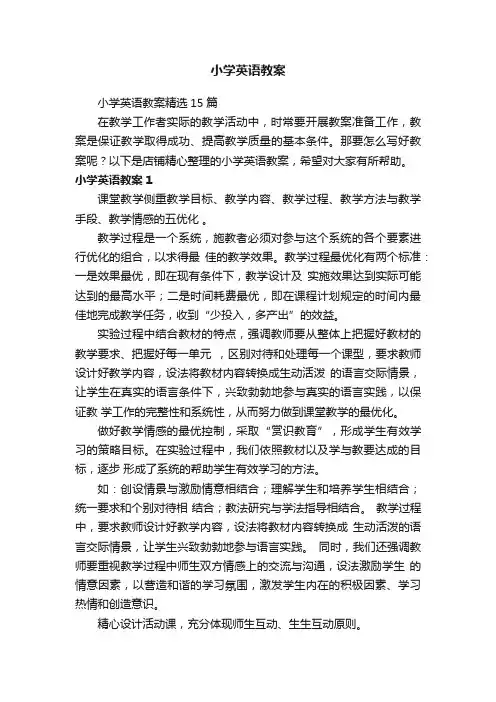
小学英语教案小学英语教案精选15篇在教学工作者实际的教学活动中,时常要开展教案准备工作,教案是保证教学取得成功、提高教学质量的基本条件。
那要怎么写好教案呢?以下是店铺精心整理的小学英语教案,希望对大家有所帮助。
小学英语教案1课堂教学侧重教学目标、教学内容、教学过程、教学方法与教学手段、教学情感的五优化。
教学过程是一个系统,施教者必须对参与这个系统的各个要素进行优化的组合,以求得最佳的教学效果。
教学过程最优化有两个标准:一是效果最优,即在现有条件下,教学设计及实施效果达到实际可能达到的最高水平;二是时间耗费最优,即在课程计划规定的时间内最佳地完成教学任务,收到“少投入,多产出”的效益。
实验过程中结合教材的特点,强调教师要从整体上把握好教材的教学要求、把握好每一单元,区别对待和处理每一个课型,要求教师设计好教学内容,设法将教材内容转换成生动活泼的语言交际情景,让学生在真实的语言条件下,兴致勃勃地参与真实的语言实践,以保证教学工作的完整性和系统性,从而努力做到课堂教学的最优化。
做好教学情感的最优控制,采取“赏识教育”,形成学生有效学习的策略目标。
在实验过程中,我们依照教材以及学与教要达成的目标,逐步形成了系统的帮助学生有效学习的方法。
如:创设情景与激励情意相结合;理解学生和培养学生相结合;统一要求和个别对待相结合;教法研究与学法指导相结合。
教学过程中,要求教师设计好教学内容,设法将教材内容转换成生动活泼的语言交际情景,让学生兴致勃勃地参与语言实践。
同时,我们还强调教师要重视教学过程中师生双方情感上的交流与沟通,设法激励学生的情意因素,以营造和谐的学习氛围,激发学生内在的积极因素、学习热情和创造意识。
精心设计活动课,充分体现师生互动、生生互动原则。
一节成功的活动课往往需要教师的周密思考,在课程设计中,教师要尽可能多地考虑师生的共同参与性与互动性,操练过程中的趣味性和交际性,充分体现学生学习的自主性和参与性。
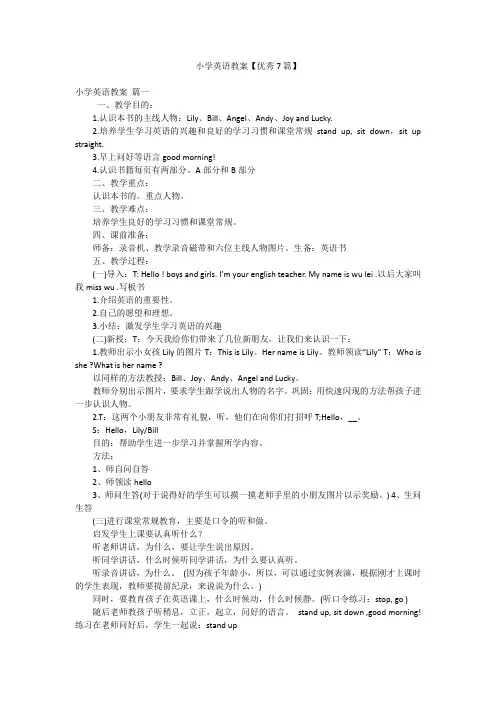
小学英语教案【优秀7篇】小学英语教案篇一一、教学目的:1.认识本书的主线人物:Lily、Bill、Angel、Andy、Joy and Lucky.2.培养学生学习英语的兴趣和良好的学习习惯和课堂常规stand up, sit down,sit up straight.3.早上问好等语言good morning!4.认识书籍每页有两部分。
A部分和B部分二、教学重点:认识本书的。
重点人物。
三、教学难点:培养学生良好的学习习惯和课堂常规。
四、课前准备:师备:录音机、教学录音磁带和六位主线人物图片。
生备:英语书五、教学过程:(一)导入:T: Hello ! boys and girls. I’m your english teacher. My name is wu lei .以后大家叫我miss wu .写板书1.介绍英语的重要性。
2.自己的愿望和理想。
3.小结:激发学生学习英语的兴趣(二)新授:T:今天我给你们带来了几位新朋友,让我们来认识一下:1.教师出示小女孩Lily的图片T:This is Lily。
Her name is Lily。
教师领读“Lily” T:Who is she ?What is her name ?以同样的方法教授:Bill、Joy、Andy、Angel and Lucky。
教师分别出示图片,要求学生跟学说出人物的名字。
巩固:用快速闪现的方法帮孩子进一步认识人物。
2.T:这两个小朋友非常有礼貌,听,他们在向你们打招呼T;Hello,__。
S:Hello,Lily/Bill目的:帮助学生进一步学习并掌握所学内容。
方法:1、师自问自答2、师领读hello3、师问生答(对于说得好的学生可以摸一摸老师手里的小朋友图片以示奖励。
)4、生问生答(三)进行课堂常规教育,主要是口令的听和做。
启发学生上课要认真听什么?听老师讲话,为什么,要让学生说出原因。
听同学讲话,什么时候听同学讲话,为什么要认真听。
人教版学校英语课程教案5篇教案在上课进程中可依据具体状况做适当的必要的调整,课后随时记录教学效果,进行简要的自我分析,有助于积累教学阅历,不断提高教学质量。
下面我给大家带来关于人教版学校英语课程教案,便利大家学习人教版学校英语课程教案1Unit1 What’s he like(第一课时)一. 教学内容Main scene Part A (let’s try let’s talk)二.教学目标1.能正确听,说,朗读“Who is … He/She is…What’s he/she like He/She is … Is he/she…Yes,he/she is. No, he/she isn’t.〞2. 能正确听,说,认读表示人物外貌与性格特征的形容词old,young,funny,kind,strict,polite,hard-working,clever.3.能听懂,会说,会表演Let’s talk 的内容并在真实场景中运用。
三.教学重点同学能够表演Main scene 和let’s talk的交际内容,能够依据实际状况用英语争辩人物。
四.教学难点用英语精确询问并答复人物特征,如:“Who is … He/She is…What’s he/she like He/She is … Is he/she…Yes,he/she is. No, he/sheisn’t.〞五.课前预备1. 教材相配套的教学课件[Unit 1 Lets learn/A]2. 教材相配套的教学录音带3. 老师自制的单词卡六、教学过程Step1. Warming-up1.Let’s look and say the names.(通过多媒体播放一些卡通图片,分别呈现年老,年轻,滑稽,有礼貌,工作努力,聪慧,严格等外貌与性格特征,让同学认读,说一说这是谁,怎么样。
)2.Let’s listen and sing〞Who’s your teacher〞Step2. Presentation1.学习Main scene(1).出示Main scene中的局部教学挂图,让同学观看Who What are they talking about(2).同学看图片想象并答复老师的问题。
PEP小学英语全册教案第一章:Unit 1 Greetings教学目标:1. 能够用英语进行基本的问候和介绍。
2. 学会使用“Hello”、“Good morning”、“Good afternoon”、“Good evening”等问候语。
3. 能够介绍自己的名字和年龄。
教学内容:1. 问候语和介绍的单词和短语:Hello, Good morning, Good afternoon, Good evening, My name is, I am, How old are you?2. 对话练习:学生之间互相问候和介绍。
第二章:Unit 2 Numbers教学目标:1. 能够认识和读写1-100的数字。
2. 学会用英语表达数字的比较。
3. 能够进行简单的数学计算。
教学内容:1. 数字的单词和短语:one, two, three, four, five, six, seven, eight, nine, ten, eleven, twelve, thirteen, fourteen, fifteen, sixteen, seventeen, eighteen, nineteen, twenty, thirty, forty, fifty, sixty, seventy, eighty, ninety, one hundred.2. 对话练习:学生之间用数字进行简单的交流和计算。
第三章:Unit 3 Colors教学目标:1. 能够认识和描述基本的颜色。
2. 学会用英语表达颜色的比较。
3. 能够用颜色单词进行简单的描述和创作。
教学内容:1. 颜色的单词和短语:red, yellow, blue, green, black, white, purple, orange, pink, brown, gray, gold, silver.2. 对话练习:学生之间用颜色单词进行描述和交流。
第四章:Unit 4 Family Members教学目标:1. 能够认识和描述家庭成员。
小学英语教学教案(通用10篇)小学英语教学教案篇1教学内容:Let’s say and Let’s sing教学目标:1、知识目标a)学生能够熟练听读、认读课文主人翁的英文名b) 学生能能熟练运用句型: Hello, Good morning,I’m … What’s your name?2、技能目标学生能够用英语自我介绍和询问别人。
鼓励学生积极参与活动,激发学生学习英语兴趣,增加他们的自信心。
3、情感目标a)在活动中,教师与学生的积极互动,营造民主和谐的英语学习氛围,学生能在英语课堂中快乐地学习。
b) 通过一些活动,培养学生合作意识。
激发学生学习英语的兴趣,鼓励学生积极参与活动,培养学生运用灵活运用英语的能力,养成活学活用的习惯。
教学重点:a)学会打招呼b)学会唱歌教学难点:缩写形式的读音教学方法:1、游戏教学法:学生通过游戏掌握本堂课的单词和句型。
在本课堂中,教师通过猜人物、表演对话等活动对单词和句型进行操练。
2、TPR全身反应法:结合低段小学生的性格特点,给相应的情节配上相应的图片和动作。
在活动中加强学生对句型的运用。
提高学生的学习兴趣。
3、实践行动法:以日常生活中打招呼的情景,操练学生口语能力。
4、歌唱教学法:通过教唱歌曲和随机改编歌曲,既可以激发学生的学习积极性,又可以巩固和复习本节课所学的内容,让学生记得更深刻和更牢固。
歌曲使人轻松、快乐。
歌曲使人记忆深刻,通过歌唱学习英语能长久记忆。
老师唱问,学生唱答,一唱一和,快唱快和,慢唱慢和,灵活贯通。
使教师和学生都感受快乐。
教学设备:老师自制的教具单词翻卡,多媒体设备教学过程:Steps Teacher’s Activities PurposeStep1 Greeting1. Greeting with Ss.2. Divide the class into two groups, boys group and girls groups. and show Ss the rules of petition. and tell Ss who can get the top of the ladder and who will be the winner of the petition. 通过分男、女组比赛,设计“分红旗”的竞赛情景,来调动学生的学习激情。
小学英语优秀教案(优秀7篇)小学英语教案篇一教学目标:知识与技能:能够听懂、会说、会认读单词:man, father, dad。
过程与方法:能够听懂、会说、会认读句型:who’s that man? he’s my father./ hi, dad.并能够在具体的语境中灵活运用。
情感态度与价值观:能够听懂指令,按照指令的要求完成point and say的内容。
教学重点:掌握三个单词和句子。
教学难点:能够理解和运用句型:who’s that man? he’s my father./ hi, dad.并能够听懂、会说、理解句子:this is my friend, amy.教学准备:照片,词卡教学过程:step1 warming up revisiona song” who is she?”(网络素材)。
a song “boy and girl”。
’s chant:p8.my friends.引导学生介绍自己的朋友。
如:hi, i’m ’m from chin is my friend, ’s a ’s a ’s from china/ the uk/ canada/ the usa/ australia. step2 presentation practice1、以旧带新,学习新知(let’s talk)(1)教师:呈现mr jones,问:who’s he?引导学生答:he’s mr jones.教师:mr jones is a man.(2)学习单词man,并扩展woman对比进行学习。
2、词融于句,巩固新知活动1:呈现男教师的照片,让学生练说: mr… is a man.活动2:呈现男明星的照片,让学生练说:如yao ming is a man. and learn(1)呈现教师自己爸爸的照片:look, that is a ’s that man? can you gu?教师出示答案:he’s my father.(2)学习father,并扩展mother对比学习。
小学英语教案全英文版(优秀13篇)小学英语全英文教案范文篇一Goood moring, Im glad to interpret my lesson here . The lesson plan I am going to talk about is Part A lets learn of unit1 PEP Primary English book7. I will explain how to teach and the reason for doing this from following aspects.Ⅰ analysis of the teaching content.Ⅰ ways of teaching and learning .Ⅰ teaching proceduresⅠ blackboard designV assessmentNow Let;s focus on the analysis of teaching content. It can be divided into 3 parts as followed: the status and the function, the teaching objectives , the main points and difficult points, I;ll talk about it one by one.This lesson is the first lesson of unit 1, book7 . It includes two parts: Let;s learn and let;s play. In section 1, it mainly deals with these key phrases: on foot, by bike, by bus, by train, by subway. And in section 2, it provides a game for the Ss to prastise the patterns: How do you go to? And the answer: I go by../ on foot.Our students have already known some vehicles in the daily life. It;s not difficult for them to understand and use these words . If students can learn it well, it will help students to learn the rest of this unit. So, I set the following aims:The first is language objectivesTo make sure that students can read, recognize and use these key phrases :on foot ,by bike,by bus,by train skillfully.The next is ability objectives(1) To develop Ss; abilities of listening and speaking.(2) To train the Ss; ability of working in groups.moral objectives(1)to help students know some vehicles and comprehend the traffic rules(2) To foster Ss; consciousness of good co-operation and proper competition.The main points and difficult points about this lesson is:(1) To make sure that Ss can use these key phrases correctly and skillfully.(2) To enable Ss to study in groups and co-operate skillfully.(3) To develop Ss; interest in English.Difficult pointsTo help the Ss ask and answer the question “How do you go to?part Ⅰways of teaching and learningAs we all know: the main instructional aims of learning English in primary school is to cultivate pupils; basic abilities of listening and speaking and their good sense of the English language. So in this lesson I;ll mainly use “Task-based” teaching method. That is to say, I will let the Ss learn in real situations, finish a task by making a survey”How do you go to school?” to help Ss to get a better understanding of the key phrases. I will arrange these activities: guessing game, finishing a survey and having a competition. And in this lesson a recorder, CAI, will be needed.partⅠ teaching proceduresI;ll finish this lesson in five steps.step1 lead--in activitiesI will begin my class with drawing and guessing game, just like this : I show students some vehicles such as bike ,bus ,jeep which they learned before by Stick Figures and ask them guess what;s it.Purpose: It is important to form a better English learning surrounding for the Ss by guessing game. and at the same time it provides situations to review learned knowledge for the next step.step2 prestentationNow I;ll mainly talk about this step.1、first there is a Free talk between T and Ss. For example: I show many pictures of beautiful cities and ask students some questions, such as do you like this city?where do you want to go ?and help Ss to answer them with by train ,by plane,by ship.By the way, I show the picture of a school, and say“ I go to schiool by bus” ,Ss read this sentence. do the actions and ask how do you go to school?,show many pictures of tools such as ,on foot by bike ,by bus to help students answer my question one by one.To present the key structures one by one is much easier for the Ss to learn and grasp the meanings.2 With the help of the CAI I set a situation to help Ss understand the way of using these key phrases:A boy is coming, who is going to school. He says: I go to school byThen play the sounds of bus, bike ask students to listen carefully and tell “I go to school by according to the different sounds, by the way , I present another new phrases:by subwayPurpose:Make Ss use these new phrases with sentence structures, to help Ss use the language in a real situation.step3 practise3 I order to make every student read these new phrases correctly, I design a drill in this step,I show cards as soon as possible ,students should read the words quickly and spell them. Then I ask How do you go to school?students answer I go to ......also I will quicken the speed to ask .The purpose is to draw the whole studentsattention to the spelling of the words4 After this, I ask Ss to do Lets play in fours. They use places cards and vehicle cards, ask and answer:How do you go to ? I go to by”5, If Ss can ask and answer expertly, I will ask them to make a short dialogue.the purpose of this is to help students to learn those sentenses through a ture situation and make the dialogues in order to check if Ss can usse these key prases、sentences structures skillfullystep 4 consolidationlet students do a survey about how do you go to school?and the table like this :write down names and tools another Ss chooseTask-based teaching method is used here to develop Ss; ability of ; communication and also their ability of co-operation will be well trained.step 5 homeworkask students to collect other kinds of transport tools through the library ,computer.the purpose of this is to stimulate the interest of learning english and to wide the studentsknowledgestep6 blackboard designmy blackboard design like this :on the left Ishow the phrases:on foot,by bus.......on the right there are many sentences:how do you go to school?I go to ......step 7 assessmentdue to the studentsage ,I make every students work in class through many activities in order to stimulate the studentsinterest and provide they a wide thinking room. I make students learn this lesson very well through desiring scene statuesthats all,thank you for your listening !Unit 1 Lesson 篇二Part A Let;s say, Let;s chant Part C CultureTeaching Aims :1、Be able to listen, say, recognize the words: apple, ant, boy, bag, Coke, coffee.2、Be able to listen, say, read and write these three letters: A a; B b; C c3、Through the chant review the letters of ABC, train a sense of group identity.Focus Points amp; Difficult Points :Read the letters: Big letter C, small letter c; Write down them correctly and handsomely.Teaching Preparation:1、Letter cards ,some word pictures, word cards: apple boy eraser ant crayon body head cake Coke coffee bag ball2、A little blackboard with four-line format and a ball.Designing for the blackboard:panda beaver eagle kangaroo (pictures)China Canada America Australia (words)Teaching Steps:Step1. Warm ndash;up1、Sing a song.2、Free talkT: Hello. I;m Wendy. I;m from Hangzhou.S1: Hello! I;m 。
小学英语优质公开课教案〔通用14篇〕小学英语优质公开课教案〔通用14篇〕小学英语优质公开课教案篇1一、教学目的:1、掌握there be构造所表达的意义。
2、能听懂和看懂包含there be句型的简短对话。
3、能运用学过词汇和there be句型来简单描绘一下某处有某物。
二、重点难点:there be句型的肯定式、否认式一般疑问句及其答复方式。
三、教学过程:1、there be概念。
there be ...句型,表示的是“存在”,“某地有某人或某物”,其构造为there be(is,are)+某物/某人+某地。
2、be动词的用法。
单数名词和不可数名词用is,复数用are.3、there is的句子构造:there is a book on the desk.there is some water in the bottle.4、there are的句子构造:there are some pictures on the wall.小学英语优质公开课教案篇2教学目的:1.能听说、认读eye, face , ear, nose, mouth,这些关于身体部位的单词,并能用英语介绍自己身体的这几个局部2.初步理解表示接触的指示用语,能听懂,并按指令做出相应的动作。
3.激发学生学习兴趣,培养听说习惯和才能。
教学重点:关于头部的单词eye, face , ear, nose, mouth的学习。
教学难点:eye, face两个单词的元音因素容易发音不到位,老师可鼓励学生张大口型,互相检查。
mouth一词的尾音发音较难,老师可适当提醒学生,注意口型教学过程:step 1.warm up and revi-sion 1.greetings :hello,boys and girls! nice to meet you! sit down please!step 2.presentation1.利用多媒体展示学生感兴趣的动画人物“大耳朵图图”,让学生与图中人物进展口语交流let’s say “hello, tutu.”2.tu tu is so cute.look! this is tutu’s eye.并指着tutu的眼睛介绍。